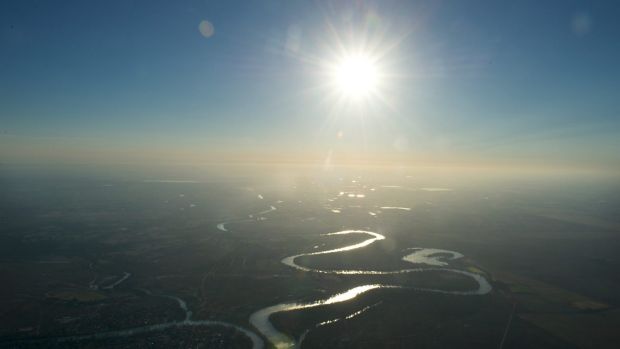Climate change likely to blame for dwindling Murray-Darling inflows, report finds

Mick Keelty’s review urges governments to stop playing politics with the basin and calls for greater transparency on water sharing
The amount of water in the Murray river system is now only about half of what it was in the preceding century and the frequency of dry years has increased, a much-awaited report has found.
The report by the interim inspector general of the Murray-Darling Basin Water Resource, Mick Keelty, has rejected a widely held view in the southern basin that the current conditions there are “a man made drought” brought on by the policies of the Murray-Darling Basin Authority and unfair extractions in the northern basin.
Instead Keelty has found that the problem is likely due to climate change and warned that this will require a rethink by the states about how they share the river.
“The past two decades or so have seen a marked change in the volume of water available in the system. Analysis shows that the median annual inflow over the past 20 years is approximately half that of the preceding century. More significantly, the frequency of drier years is also much greater,” Keelty found.
 He said that peoples’ memories of the river, and much of the expansion in irrigation in the southern basin, had occurred at a time when inflows were greater, between the second world war and the 1990s.
He said that peoples’ memories of the river, and much of the expansion in irrigation in the southern basin, had occurred at a time when inflows were greater, between the second world war and the 1990s.
“While there may be many factors contributing to the extent of observed inflow reductions, the lack of rainfall and runoff has been the primary driver for the conditions being experienced by many across the Basin in recent times,” he said.
“Implications for future trends – particularly arising from the impacts of climate change – remain uncertain,” Keelty said, referring to work that is now being done by the CSIRO for the Murray-Darling Basin Authority.
Keelty’s findings appear aimed at trying to quell the increasingly toxic debate over management of Australia’s largest river system and to inject more science into it.
“Given the marked decrease in inflows over the past two decades it is important that the appropriateness of existing arrangements is reassessed in the context of the changes that are occurring and a future that may be characterised by further extremes,” Keelty said.
He called on governments to stop playing politics with the Murray-Darling Basin Plan.
He said many of the concerns about the plan were “fuelled by uncertainty, misinformation, misperceptions or misappropriation of available information” and the debate around the plan had become “increasingly toxic”.
In remarks that appear to be addressed to New South Wales, Keelty said: “ In the absence of strong, Basin-wide leadership, there is a perception that some parties are too busy ‘playing politics’ and are ineffectual at making any tough decisions –especially when it comes to making decisions in the national interest and at the ‘whole of Basin’ level.”
“A more unified Basin-wide position and plan of action for Basin Plan implementation is required across all levels of government to improve leadership in the Basin and address the current crisis in confidence,” he said.
On the reduced flows from the Darling into the Murray, Keelty noted there were multiple factors, including the activities of irrigators in the north, but added the Darling only historically contributed 8% to the Murray’s flows.
“Inflows both into the Menindee Lakes and from the Lakes to the River Murray have dramatically reduced in the last 20 years,” he said.
“There may be numerous factors contributing to this, including record low inflows in northern NSW, lower rainfall, higher temperatures, catchment modification (including farm dams), increasing development, floodplain harvesting, changes in extraction rules in water-sharing plans, and non-compliance,” he said.
But he said the relative influence of each of these factors had not been established and more work by the MDBA was needed.
He has also called for the MDBA and the states to be more transparent on water sharing and how they manage water accounts so that water users can understand how water is being allocated.
One of the gripes in the southern basin has come from the dairy industry and other irrigators who rely on less secure water entitlements, which have seen their allocations cut over time. There has also been concerns by Victoria and NSW about allocations to South Australia.
 “Many of the concerns that the inquiry heard might have been redundant if individuals were able to readily see and understand the way available water has been shared over time,” Keelty said.
“Many of the concerns that the inquiry heard might have been redundant if individuals were able to readily see and understand the way available water has been shared over time,” Keelty said.
“Holders of NSW General Security and Victorian Low Reliability water share entitlements feel they have been disproportionately affected. There is a high likelihood that historical expectations of reliability are no longer accurate because climatic conditions have changed,” he said.
“Underpinning many irrigators’ frustrations is also the fact that there is very little data available about the long-term reliability of different entitlement types. This is undermining confidence in the water allocation process,” he said.
“Coordinated and strategic leadership will help by providing more certainty about water reform in the long-term, which will be beneficial for everyone in the Basin,” he said.
Keelty also rejected calls to give up environmental water for agriculture during droughts, noting that some of these calls are based on a misconceptions that environmental water gets priority during droughts, when in fact its allocations are reduced in the same way as irrigators’ entitlements are cut.
The minister for resources, water and northern Australia, Keith Pitt, said he would accept all five of Keelty’s recommendations, which centre on transparency and greater information on how the plan works.
Pitt said this was one of three reports that would inform the commonwealth and states in the future management of the Murray-Darling Basin.
The other two – the Sefton report on socio-economic conditions in basin communities and the competition regulator’s report on the water market, sparked by allegations of water speculation – are still to come. The Sefton report is due at the end of the month and the ACCC report is due mid-year.
The MDBA also welcomed the report.
“We know some irrigators will feel disappointed that the report has not unearthed any new water for communities doing it tough because of the drought, however it does show that every drop is accounted for and is made available to the state governments to manage and allocate according to their rules,” the MDBA chief executive, Phillip Glyde, said.
“We’ve commissioned the CSIRO to model possible climate scenarios that we could face by 2050 in the northern and southern Basin. This research will help us all to better understand what changes are required to ensure we all have a sustainable future,” he said.
Originally published by The Guardian, 17 April 2020.
